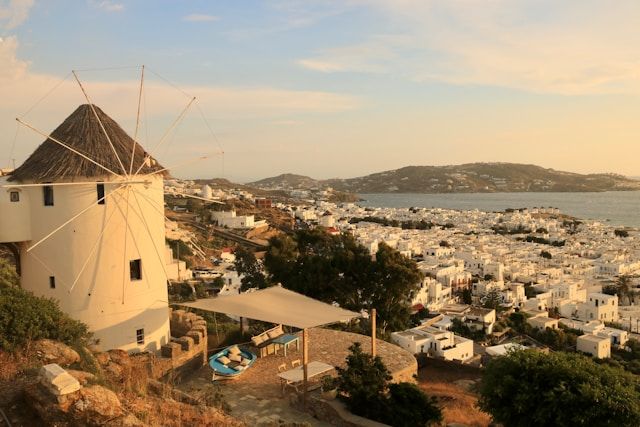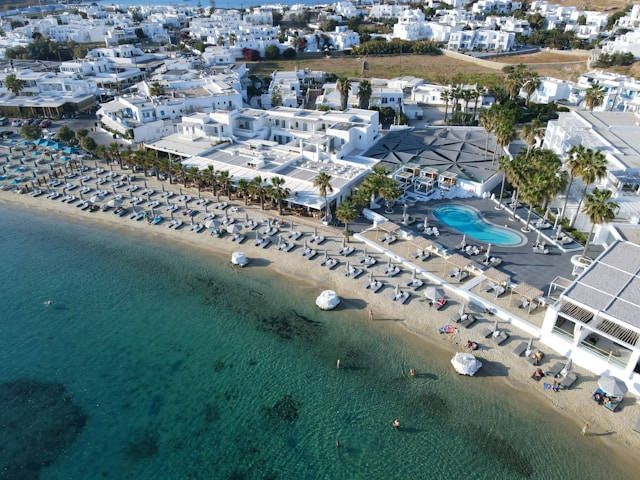Mykonos, the Most Sophisticated Island in Greece
Although Mykonos is dry, with scarce vegetation, its beaches and lively nightlife make it one of the most popular islands within the Cyclades archipelago.
Dominated by the Venetians since 1207, the islanders established the Community of Mykonians in 1615 and thus managed to become self-reliant. Visited by intellectuals in the early days, today Mykonos lives up to its reputation as the stylish island in Greece.
The capital of Mykonos, also called Chora, is the prototype of a Cycladic village: a tangle of blazing white alleys and cubic-shaped houses. Its operating port, built in a labyrinth of narrow streets to protect itself from the wind and pirate attacks, is one of the most photographed in Greece.

Exploring Mykonos
Specifically, the hydrotaxis that goes to the island of Delos, as mentioned in the previous article on Mykonos, links leave the seafront. Nearby, you can see the pelican Petros II, the island's mascot, busy fishing.
The Mavrogenous Square, adjacent to the port, is presided over by the bust of the revolutionary heroine Manto Mavrogenous (1796-1848), who achieved a general’s rank by defeating the Turks in Mykonos during the War of Independence in 1821.
The Archaeological Museum, housed in a neoclassical building at the south of the ferry dock, contains an extensive collection of Roman and Hellenistic sculptures, pottery from the 6th and 7th centuries BC, jewelry and tombs, as well as numerous finds from the Delos site.
Kastro, the oldest part of the city, is further up the port area. The excellent Ethnographic Museum, one of the best in Greece, was built on a section of the old castle wall; It occupies an elegant ship captain's mansion and houses a valuable collection of ancient and modern Mykonos pottery, embroidery, and textiles.
One of the most striking pieces is the genuine Petros pelican, now embalmed, which was the island's pet for 29 years.
Vonis mill, dating to the 16th century, has been restored and is back in operation; It was one of the 30 windmills that the families of the island used to grind their corn harvest.

The Beautiful and Exclusive Beaches of Mykonos
The fame of Mykonos lies in its beaches, as it is not a green island. The best of them are on the south coast of the island. Platys Gialos, 3.5 km south of the city, is the quintessential family beach, with water sports and a long stretch of sand. Those who want to get a full tan can head to the famous nude beaches. The first is Paraga, or Agia Anna, a quiet corner with a good tavern. The next is Paradise, with camping, disco, and water sports. Elia, also a nudist beach, becomes full during the high season. In contrast in the interior of Mykonos in the village of Ano Mera, 7.5 km to the east, people live untouched by tourism. Its main attraction is the 16th-century monastery of Panagia Tourliani, dedicated to the patroness of the island. Founded by two monks from Paros, the monastery, with its red dome, was restored in 1767. The ornate marble tower was sculpted by artisans from Tinos. Inside there are beautiful 16th-century icons, chasubles (liturgical vestment, ts,) and embroidery. To the northwest of the town stands Palaiokastro Hill, once crowned by a Venetian castle believed to be the site of one of the ancient cities of Mykonos. What is seen today is Moni Palaiokastrou, a nunnery (female monastery) dating to the 18th century and in typicCycladicdic architecture. To the northwest, in the pretty village of Marathi, there is Moni Agiou Panteleimona, founded in 1665; from here, the road continues to Panormos and FtelBaybay, a paradise for windsurfers.
Discover Mykonos
As you can see, Mykonos offers a great adventure and beautiful beaches to enjoy the sea, and the sun and relax. Explore our packages to Mykonos!

